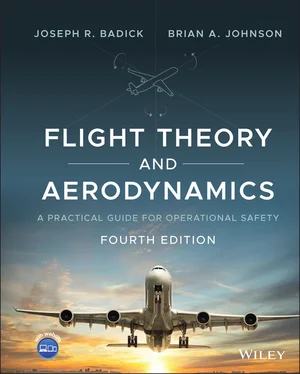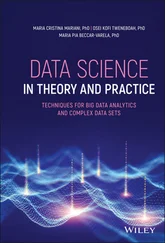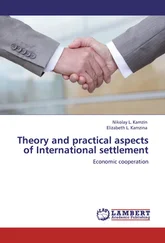Joseph R. Badick - Flight Theory and Aerodynamics
Здесь есть возможность читать онлайн «Joseph R. Badick - Flight Theory and Aerodynamics» — ознакомительный отрывок электронной книги совершенно бесплатно, а после прочтения отрывка купить полную версию. В некоторых случаях можно слушать аудио, скачать через торрент в формате fb2 и присутствует краткое содержание. Жанр: unrecognised, на английском языке. Описание произведения, (предисловие) а так же отзывы посетителей доступны на портале библиотеки ЛибКат.
- Название:Flight Theory and Aerodynamics
- Автор:
- Жанр:
- Год:неизвестен
- ISBN:нет данных
- Рейтинг книги:4 / 5. Голосов: 1
-
Избранное:Добавить в избранное
- Отзывы:
-
Ваша оценка:
- 80
- 1
- 2
- 3
- 4
- 5
Flight Theory and Aerodynamics: краткое содержание, описание и аннотация
Предлагаем к чтению аннотацию, описание, краткое содержание или предисловие (зависит от того, что написал сам автор книги «Flight Theory and Aerodynamics»). Если вы не нашли необходимую информацию о книге — напишите в комментариях, мы постараемся отыскать её.
AERODYNAMICS
GET A PILOT’S PERSPECTIVE ON FLIGHT AERODYNAMICS FROM THE MOST UP-TO-DATE EDITION OF A CLASSIC TEXT Flight Theory and Aerodynamics
Flight Theory and Aerodynamics
Flight Theory and Aerodynamics
Flight Theory and Aerodynamics — читать онлайн ознакомительный отрывок
Ниже представлен текст книги, разбитый по страницам. Система сохранения места последней прочитанной страницы, позволяет с удобством читать онлайн бесплатно книгу «Flight Theory and Aerodynamics», без необходимости каждый раз заново искать на чём Вы остановились. Поставьте закладку, и сможете в любой момент перейти на страницу, на которой закончили чтение.
Интервал:
Закладка:
6 Chapter 6Figure 6.1 Aircraft in equilibrium flight.Figure 6.2 Turbojet engine.Figure 6.3 Turbofan engine.Figure 6.4 Dual‐spool axial‐flow compressor.Figure 6.5 Jet engine compressor stall.Figure 6.6 T‐38 drag curve.Figure 6.7 T‐38 thrust required.Figure 6.8 Engine thrust schematic.Figure 6.9 Propulsion efficiency.Figure 6.10 Variation of thrust with rpm.Figure 6.11 Typical jet acceleration times.Figure 6.12 T‐38 installed thrust.Figure 6.13 T‐38 thrust variation with altitude.Figure 6.14 T‐38 c t–rpm.Figure 6.15 T‐38 c t–altitude.Figure 6.16 T‐38 fuel flow–altitude.Figure 6.17 T‐38 thrust available–thrust required.Figure 6.18 Forces acting on a climbing aircraft.Figure 6.19 Velocity for maximum climb angle.Figure 6.20 Wind effect on climb angle to the ground.Figure 6.21 Obstacle clearance for jet takeoff.Figure 6.22 Climb angle and rate of climb.Figure 6.23 Rate of climb velocity vector.Figure 6.24 Velocity for maximum rate of climb.Figure 6.25 Finding maximum endurance velocity.Figure 6.26 Finding the maximum specific range velocity.Figure 6.27 Wind effect on specific range.Figure 6.28 Total range calculation.Figure 6.29 Effect of weight change on induced drag.Figure 6.30 Effect of weight change on the T rcurve.Figure 6.31 Effect of weight change on specific range.Figure 6.32 Effect of configuration on parasite drag.Figure 6.33 Effect of configuration on the T rcurve.Figure 6.34 Effect of altitude on T rand T a, curves.Figure 6.35 Range improvement using cruise–climb.
7 Chapter 7Figure 7.1 Airfoil sections of a propeller blade.Figure 7.2 Propeller tip speed versus propeller hub.Figure 7.3 Propeller blade angle.Figure 7.4 Geometric pitch versus effective pitch.Figure 7.5 Blade angle in flight.Figure 7.6 Various blade angle ranges.Figure 7.7 Thrust from a propeller.Figure 7.8 Propeller pitch angle configurations.Figure 7.9 Propeller range positions.Figure 7.10 (a) Thrust‐required and (b) power‐required curves.Figure 7.11 Power required.Figure 7.12 Power available curve.Figure 7.13 Power required and power available.Figure 7.14 Fixed‐shaft turboprop engine.Figure 7.15 Split shaft/free turbine engine.Figure 7.16 Turbocharged engine.Figure 7.17 Forces on a climbing aircraft.Figure 7.18 Thrust versus climb angle.Figure 7.19 Climb angle versus velocity.Figure 7.20 Comparison of maximum AOC between jet and propeller airplanes....Figure 7.21 Rate of climb velocity vector.Figure 7.22 Comparison of maximum ROC between jet and propeller airplanes....Figure 7.23 Finding the maximum rate of climb.Figure 7.24 Finding the maximum endurance and range.Figure 7.25 Effect of wind on range.Figure 7.26 Effect of weight change on a P rcurve.Figure 7.27 Effect of weight change on specific range.Figure 7.28 Effect of configuration on the P rcurve.Figure 7.29 Effect of altitude on a P rcurve.Figure 7.30 V Xversus V Ywith altitude.Figure 7.31 Effect of altitude on specific range.
8 Chapter 8Figure 8.1 Takeoff distance graph.Figure 8.2 Normal takeoff and climb.Figure 8.3 Crosswind takeoff.Figure 8.4 Short‐field takeoff.Figure 8.5 Soft‐field takeoff.Figure 8.6 Water drag and propeller thrust on takeoff.Figure 8.7 Hydrodynamic lift while on the step.Figure 8.8 Premature takeoff.Figure 8.9 Accelerate‐stop distance, accelerate‐go distance, and climb gradi...Figure 8.10 Balanced field length.Figure 8.11 Single‐engine velocity–distance profiles.Figure 8.12 Multi‐engine velocity–distance profiles.Figure 8.13 FAR takeoff field length.Figure 8.14 RTO and tire failure.Figure 8.15 Performance chart examples.Figure 8.16 Jet takeoff and departure profile.Figure 8.17 Segmented one‐engine climb graph.Figure 8.18 Forces on an airplane during takeoff.Figure 8.19 Effect of wind on takeoff.Figure 8.20 Takeoff distance chart with runway surface adjustment.Figure 8.21 U.S. Chart Supplement information.
9 Chapter 9Figure 9.1 Landing distance graph.Figure 9.2 Forces in equilibrium.Figure 9.3 Forces acting in a power‐off glide.Figure 9.4 Glide ratio vector diagram.Figure 9.5 Jet approach and landing profile.Figure 9.6 FAR landing field length required.Figure 9.7 Stabilized approach for a jet aircraft.Figure 9.8 Approach glide paths.Figure 9.9 Approach glide path views from the flight deck.Figure 9.10 Lift from (a) propellers and (b) turbojets.Figure 9.11 Coefficient of lift comparison for flap extended and retracted p...Figure 9.12 Effect of flaps on final approach.Figure 9.13 Changing angle of attack during landing.Figure 9.14 Improper drift correction.Figure 9.15 Sideslip during crosswind.Figure 9.16 Short‐field approach and landing over an obstacle.Figure 9.17 Soft/rough‐field approach and landing.Figure 9.18 High round out.Figure 9.19 Bouncing during touchdown.Figure 9.20 Porpoising during round out.Figure 9.21 Go‐around procedure.Figure 9.22 Forces on tire: (a) static condition, (b) rolling tire.Figure 9.23 Hydroplaning forces on tire: (a) low speed, (b) medium speed, (c...Figure 9.24 Forces acting on an airplane during landing.Figure 9.25 Aerodynamic braking and wheel braking.Figure 9.26 Normal and friction forces.Figure 9.27 Coefficient of friction versus wheel slippage.Figure 9.28 Effect of runway condition on coefficient of friction.Figure 9.29 Thrust reversers.Figure 9.30 Effect of wind on landing.Figure 9.31 Effect of headwind during landing approach.
10 Chapter 10Figure 10.1 Effect of sweepback on C L– α curves.Figure 10.2 Regions of normal and reversed command.Figure 10.3 Constant airspeed climb. Stick or throttle?Figure 10.4 Region of reversed command for a power producer.Figure 10.5 Spanwise lift distribution.Figure 10.6 Wing spanwise lift distribution.Figure 10.7 Stall patterns.Figure 10.8 Stall recovery template.Figure 10.9 Power‐off stall and recovery.Figure 10.10 Secondary stall due to improper stall recovery.Figure 10.11 Stall speed chart.Figure 10.12 Spin entry and recovery.Figure 10.13 Stall hitting the horizontal tail.Figure 10.14 Swept wings stall at tips first.Figure 10.15 Aerodynamics of spin for straight‐wing aircraft.Figure 10.16 Aerodynamics of spin for swept‐wing aircraft.Figure 10.17 Wind shear caused by a downdraft.Figure 10.18 “Bursts” caused by a thunderstorm.Figure 10.19 Thunderstorm gust front.Figure 10.20 Temperature inversion LLWS.Figure 10.21 Tailwind wind shear encountered on takeoff: (a) flight path, (b...Figure 10.22 Tailwind shear encountered in landing approach: (a) flight path...Figure 10.23 Wingtip vortices behind an aircraft.Figure 10.24 Helicopter vortices.Figure 10.25 Wake turbulence avoidance.Figure 10.26 Wake turbulence avoidance procedures
11 Chapter 11Figure 11.1 Overbanking tendency.Figure 11.2 Forces on an aircraft in a coordinated level turn.Figure 11.3 Load factors at various bank angles.Figure 11.4 Forces on an aircraft during a 90° roll.Figure 11.5 Increase in stall speed with load factor.Figure 11.6 Load factor and stall speed.Figure 11.7 First‐stage construction of a V–G diagram.Figure 11.8 Second‐stage construction of V–G diagram.Figure 11.9 Antisymmetrical loading.Figure 11.10 Maneuver speed.Figure 11.11 Ultimate load factors.Figure 11.12 Stall speed and turn radius with varying angle of bank.Figure 11.13 Rate and radius of a turn.Figure 11.14 Constant altitude turn performance.Figure 11.15 Forces on the complete aircraft.Figure 11.16 Thrust‐limited turn radius.Figure 11.17 Perfect and normal loop.Figure 11.18 Centripetal force in a vertical loop.Figure 11.19 Loading on an example aircraft.
12 Chapter 12Figure 12.1 Types of static stability.Figure 12.2 Dynamic stability.Figure 12.3 Positive static and negative dynamic stability.Figure 12.4 Positive static and neutral dynamic stability.Figure 12.5 Positive static and positive dynamic stability.Figure 12.6 Key weight and balance locations on an aircraft.Figure 12.7 Weight and balance diagram and computational method calculation....Figure 12.8 Effect of load distribution on balance.Figure 12.9 Airplane reference axes.Figure 12.10 Establishing positive moment direction.Figure 12.11 Airplane axes and moment directions.Figure 12.12 Movement of the longitudinal axis in pitch.Figure 12.13 Positive static longitudinal stability.Figure 12.14 Types of static longitudinal stability.Figure 12.15 Degrees of positive static stability.Figure 12.16 Aircraft static longitudinal stability.Figure 12.17 Effect of CG and AC location on static longitudinal stability....Figure 12.18 Static longitudinally stable flying wing in equilibrium.Figure 12.19 Airplane with static longitudinal stability.Figure 12.20 Pressure distribution about a body of revolution.Figure 12.21 Thrust line and longitudinal stability.Figure 12.22 Power changes and longitudinal stability.Figure 12.23 Engine nacelle location contribution to pitch stability.Figure 12.24 Lift of horizontal stabilizer produces a stabilizing moment.Figure 12.25 Effect of speed on tail‐down force.Figure 12.26 Typical buildup of aircraft components.Figure 12.27 Effect of CG location on static longitudinal stability.Figure 12.28 Stick free–stick fixed stability.Figure 12.29 Phugoid longitudinal dynamic mode.Figure 12.30 Short period dynamic mode.Figure 12.31 Forces on a pitching plane.Figure 12.32 Wing wake influences on a low‐tail aircraft.Figure 12.33 Wing wake influences on a sweptwing T‐tail aircraft.Figure 12.34 Change in pressure distribution at stall.Figure 12.35 Sweptwing stall characteristics.Figure 12.36 Forces producing moments during takeoff.
Читать дальшеИнтервал:
Закладка:
Похожие книги на «Flight Theory and Aerodynamics»
Представляем Вашему вниманию похожие книги на «Flight Theory and Aerodynamics» списком для выбора. Мы отобрали схожую по названию и смыслу литературу в надежде предоставить читателям больше вариантов отыскать новые, интересные, ещё непрочитанные произведения.
Обсуждение, отзывы о книге «Flight Theory and Aerodynamics» и просто собственные мнения читателей. Оставьте ваши комментарии, напишите, что Вы думаете о произведении, его смысле или главных героях. Укажите что конкретно понравилось, а что нет, и почему Вы так считаете.












